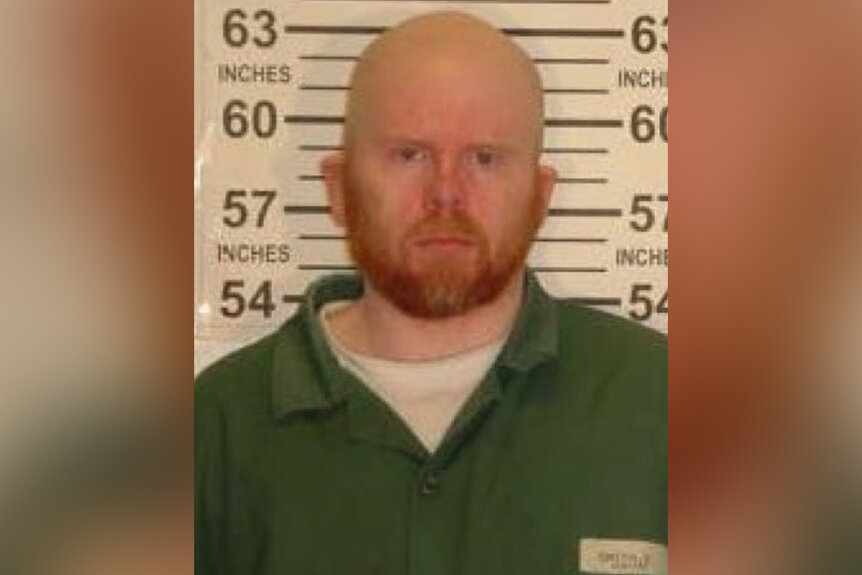Create a free profile to get unlimited access to exclusive videos, breaking news, sweepstakes, and more!
Release Of Inmate Who Murdered Neighbor's Child When He Was 13 Highlights Issues Around Juvenile Justice
Eric Smith was just 13 years old when he left Derrick Robie dead in a patch of woods in Savona, NY on Aug. 2, 1993. His release from prison comes at a moment when sentencing for young offenders is in flux.
As he sat in a courtroom in upstate New York, just before 10 p.m. on Nov. 8, 1994, Eric Smith showed no emotion as the verdict at his murder trial was read aloud. Guilty, the court heard, in the second degree. The Steuben County jury had been unanimous in their decision, believing prosecutors that Eric was undeniably guilty of one of the most heinous crimes imaginable: choking and bludgeoning his young neighbor, 4-year-old Derrick Robie, with a rock after he’d lured him into a small patch of woods in their town of Savona. That summer day, for the first time ever, Derrick had been allowed to walk alone to his nearby day camp.
Eric was just 13 years old when he left Derrick dead in that patch of woods on Aug. 2, 1993. When the jury’s verdict was read aloud, sealing his fate, he remained expressionless, merely casting his eyes downward.
One particular photograph of young Eric, as he sat in the Steuben County courtroom in the county seat of Bath during the contentious and closely watched trial went viral before there was such a term for when an image burns into the nation’s consciousness. Red-haired and ruddy-skinned, wearing thick glasses and a Bugs Bunny sweatshirt, this seemingly cold, perhaps perplexed, or maybe calculating young teen looks like the type of bookworm likely subjected to brutal bullying by his peers — which, by all accounts, Eric consistently had been — than a child capable of what he did: coax his sweet, younger neighbor with the promise of a shortcut, then choke him, bludgeon him with a 26-pound rock, and finally sodomize him with a stick.
Such an atrocity, and from someone so young, with no explanation, is difficult to stomach. And for Derrick’s parents, and many of those involved in the case, impossible to ever forgive, even decades later.
“As you listen, ask yourself if it is his mom's fault? His dad's fault? Is it his doctor's fault? Maybe even Stephen King's fault?” Steuben County prosecutor John Tunney had said during the trial to the jury made up of six men and six women, conceding that the boy certainly had mental health issues. “Eric Smith doesn't present to us an absence of problems. ... But a person who has a fascination or desire to hurt others doesn't mean that person is not responsible for his acts."
On Oct. 5, Smith, now 41, appeared before the Board of Parole for the 11th time and was granted an open release date, the New York Department of Corrections and Community Supervision confirmed in an email to Oxygen.com. Smith may walk out of Woodbourne Correctional Facility in the Catskills as early as Wednesday. At the hearing, Smith detailed his crime, saying that after he had choked and bludgeoned Derrick that day, he became worried when he realized the boy’s heart was still beating. After attempting to poke him through the eye and chest with the stick, he sodomized the boy, as a last resort, he told the parole board. This, he explained to the panel, was the culmination of his heinous act, which came after a childhood of parental abuse from his father and relentless bullying by his peers.
“After years of reflection, looking at who I was then and what was going on, I essentially became the bully that I disliked in everything else in my life,” Smith told the board. “I was constantly being targeted being weaker, smaller, and I became the bully towards him and he didn’t deserve it.”
As Smith has served his sentence, having been moved from the juvenile justice system into an upstate prison, Dale and Doreen Robie have vehemently opposed his release, every single time their son’s killer faced the parole board over the past 17 years. When the decision to release Smith was announced in October, they declined to comment to local media.
Smith’s release comes at a moment of flux in attitudes and legal decisions about how the U.S. justice system treats juvenile offenders. After two decades of movement toward leniency in juvenile justice, the Supreme Court, now with three justices appointed by former President Donald Trump, in April made a surprising 180. The high court ruled, in a 6-3 decision in the case of Jones v. Mississippi, that a judge need not make a finding of "permanent incorrigibility" before handing a juvenile offender a sentence of life without parole.
Currently, 25 U.S. states and the District of Columbia have banned life sentences without the possibility of parole for minors; in nine other states, no inmate is serving such a sentence for an offense committed as a minor. This has come after more than 15 years of SCOTUS decisions — beginning with the banning of execution of minors with the 2005 Roper v. Simmons decision— that has looked at the new scientific evidence that shows that juveniles are less culpable than adults.
This took a step forward in the arguments heard ahead of the high court’s 2010 Graham v. Florida ruling, which involved a Jacksonville teen accused of repeated robberies. How the adolescent brain differs physiologically from the adult brain, and how such differences influence a juvenile’s judgmental abilities has led to a movement toward applying neuroscientific discoveries to legal standards. This legal precedent, along with our now-deeper understanding of the development of the brain’s prefrontal cortex in the first 20 years of human life, was buttressed two years later with 2012’s Miller v. Alabama decision, the case that deemed life without parole for adolescents unconstitutional.
“It is increasingly clear that adolescent brains are not yet fully mature in regions and systems related to higher-order executive functions such as impulse control, planning ahead, and risk avoidance,” the court noted while ruling on Miller v. Alabama, referencing a brief from the American Psychological Association.
In its April about-face, which sways the justice system toward implementing one of the harshest legal punishments possible for young offenders, the Supreme Court’s new conservative majority declared that discretionary sentencing is “constitutionally necessary and constitutionally sufficient.” In his opinion, Justice Brett Kavanaugh — who in 2018 replaced Justice Anthony Kennedy, the court’s steadfast swing voter on the topic of life sentences — acknowledged that such a matter “raises profound questions of morality and social policy.” Kavanaugh added that states, local jurisdictions, and members of the public make such moral and policy judgments via sentencing laws and trial outcomes, whether by judge or jury.
Writing for the minority in April, Justice Sonia Sotomayor bristled at this notion from Kavanaugh, declaring that the court’s majority "is fooling no one" with such distortions of legal precedent.
The crux of these profound questions of morality and social policy, of course, center on how one interprets the goals of the justice and penal system. Do we merely seek vengeance and retribution through the courts and prisons? Should our sentencing guidelines exist to incapacitate the guilty — or perhaps to deter others from similar crimes? Or do we truly believe that the nation’s prisons offer the opportunity to rehabilitate and restore offenders?
Smith’s case, and the decision to grant him parole, are polarized along these lines. As CBS News reported in 2004, at the time that he was up for his first parole hearing, Smith and his attorney cited the intensive counseling he’d undergone during six years at Brookwood Juvenile Detention Center. At his 1994 trial, his defense attorney presented a diagnosis that Eric had Intermittent Explosive Disorder — a rare condition in which a person has episodes of uncontrollable violent impulses; Eric had undergone testing, including probes of his brain function and hormone levels, from doctors on both sides of the case. The jury was ultimately more convinced that this is too rare of a condition and believed the prosecution's expert witness, who testified that IED isn’t seen in many 13-year-olds.
Clinical Psychologist Jay Slosar, who handles juvenile assessments and competency, said that this was something of a long-shot defense and in 1994, a disorder that had only recently been introduced to the psychology community. Discussing adolescent brain development with Oxygen.com in a recent interview, Slosar pointed to some research that shows the brain is fully developed even later in life.
“The strongest research that has been spreading is that the brain reaches full maturation at 25,” he said. “That has been used extensively by the American Psychological Association in [terms of] sentencing for adults. My thought would be that sentencing for a crime this horrible, when the person is 25 and has gone through a program, a thorough evaluation should then be done to decide.”
In 2004, at 23 years old and after years of rehabilitation and prison time, Smith gave a contrite and unfeigned statement to the parole board as he tried to seek his freedom.
"I know my actions have caused a terrible loss in the Robie family. And for that, I am truly sorry," he said, nearly 20 years ago. "I’ve tried to think as much as possible what Derrick will never experience. His 16th birthday. Christmas, anytime. Owning his own house. Graduating. Going to college. Getting married. His first child. If I can go back in time, I would switch places with Derrick and endure all the pain I’ve caused him. If it meant that he would go on living. I’d switch places, but I can’t."
Tunney, who prosecuted Smith when he was a teen, told CBS News at the time of that 2004 hearing that there’s no way that Smith should be freed.
“I don't doubt for a second, never have doubted, that had he not been caught, Eric Smith would have killed again,” he told the network. “And that's terrifying.”
In October, following the announcement that Smith would be freed, Tunney, who still works part-time for the Steuben County DA’s office, showed little confidence in Smith’s rehabilitation.
“I have no reason to believe that’s the case. Our prison system doesn’t have a particularly good record of rehabilitation,” he told Elmira station WETM. “But I’m hoping he proves the exception. … I frankly hope Eric Smith does well. Nobody, nobody is better off if he fails."
The Robies seem to agree with Tunney's initial sentiment on Smith's rehabilitation — at each of his biannual parole hearings, they have opposed his release. They have also pushed on behalf of victims’ families for parole hearings to be extended from two to five-year intervals and became staunch advocates for Penny's Law, which lengthens the prison sentence for adolescents who kill.
"A lot of people don’t understand. They say that maybe we should just move on, which we have. We move on," Doreen Robie told CBS News in 2004. "But, as life evolves, we also carry with us this huge burden of making sure that people don’t forget him."
While the couple has not spoken to the media regarding Smith’s release, members of a Facebook event called “Justice for the Robie’s” are set to hold a candlelight walk in Savona on Wednesday. The walk, during which Smith’s name is not to be seen, will end at Derrick Robie’s memorial near Savona’s Little League baseball fields, according to the event's creator.
It’s unclear if Smith will be released on his open date, or if he plans to return to Savona, or even to Steuben County, the only place he’s ever known freedom. According to the Department of Corrections and Community Supervision, as of Tuesday, Smith does not yet have an approved residence.
Regardless of where he decides to live, his brutal crime as a child assures that legally, he will be monitored on parole for the rest of his life.




























